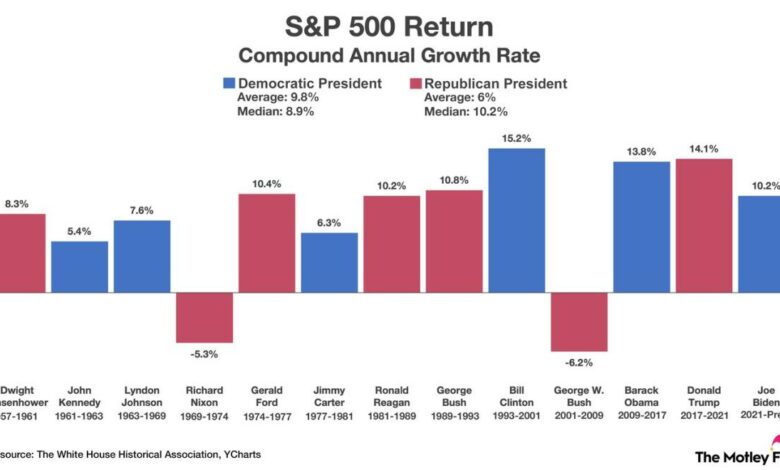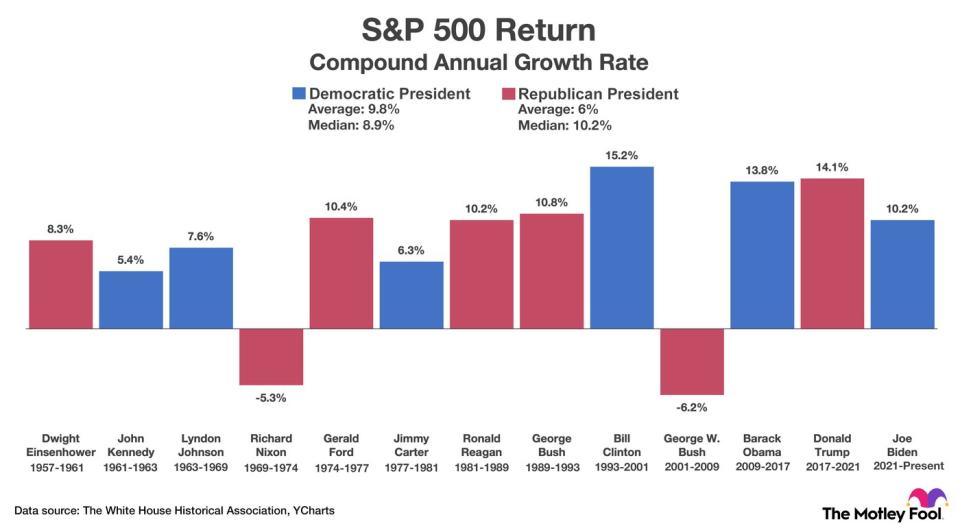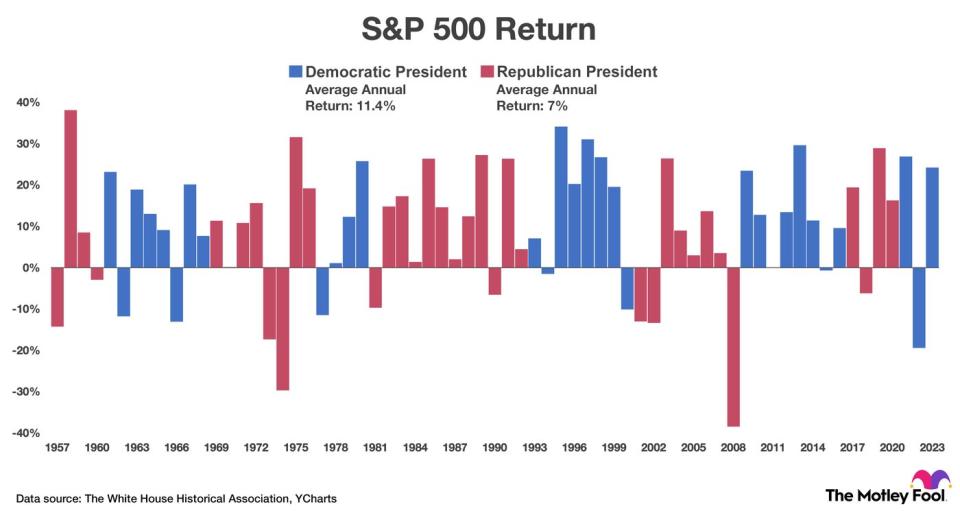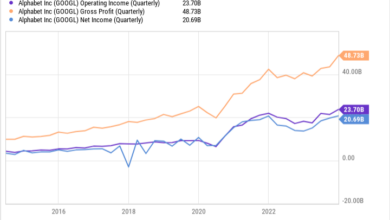Here’s the Average Stock Market Return Under Democratic and Republican Presidents

The S&P 500 (SNPINDEX: ^GSPC) is one of three major U.S. financial indexes, but its scope and diversity makes it the best barometer for the overall stock market. The index tracks 500 large U.S. companies that span all 11 market sectors, and it includes value stocks and growth stocks that account for 80% of domestic equities by market capitalization.
The S&P 500 advanced 30% over the past year as investor sentiment has flipped from bearish to bullish. Factors contributing to that change of mood include surprisingly strong economic growth, better-than-expected financial results, enthusiasm about artificial intelligence, and hopes that the Federal Reserve will begin cutting interest rates soon.
However, with the next presidential election just months away, investors may wonder how the stock market has performed under Democratic and Republican presidents. Read on to learn the answer.
The average stock market return under Democratic and Republican presidents
Since its inception in March 1957, the S&P 500 has increased 11,830% in value, compounding at 7.4% annually. That compound annual growth rate (CAGR) does not account for dividends doled out along the way, meaning the total return would be much higher.
The following chart shows the S&P 500’s CAGR during each presidency since the index was created. It also shows the average CAGR and median CAGR under Democratic and Republican presidents.

The S&P 500 has achieved an average CAGR of 9.8% under Democratic presidents and 6% under Republican presidents. However, the index has achieved a median CAGR of 8.9% under Democratic presidents and 10.2% under Republican presidents. That means both political parties can correctly claim the stock market performs better when they control the White House.
We can also look at the problem from a different perspective. The next chart shows the S&P 500’s return in each individual year since March 1957. It also shows the average annual growth rate (AAGR) when Democrats and Republicans held the presidency.

The S&P 500 achieved an AAGR of 11.4% under Democratic presidents and 7% under Republican presidents. Those figures are useful because they provide context on year-by-year performance, but there are two major flaws in the chart.
First, presidential inaugurations are slightly offset from calendar years because they usually occur on Jan. 20 following an election year. Second, AAGR is generally an inferior measure of performance compared to CAGR because it does not account for compounding, which makes it a very misleading metric.
For instance, consider a hypothetical stock worth $100 per share. If the stock rises 50% (to $150) in the first year, then declines 50% (to $75) in the second year, the AAGR equals zero but the CAGR equals negative 13.4%. Of the two numbers, the CAGR clearly paints a more accurate picture because the actual stock price declined 25% during that two-year period.
History says patient investors will be rewarded regardless of which political party controls the White House
I want investors to be crystal clear on two things. First, statistics can be manipulated to achieve a desired outcome. In this case, Republicans and Democrats can both claim the stock market has performed better when they control the presidency, and both parties would be correct.
Second, the president has no direct control over the stock market. While the president influences fiscal policy to varying degrees, Congress ultimately creates the federal budget, and, more importantly, government spending is only one of many variables that affect the stock market. To illustrate my point, consider events like the dot-com bubble, the Great Recession, and the COVID-19 pandemic. No president caused those events, but all three events caused stock market crashes.
So with the next presidential election on the horizon, both candidates may claim to be better for the stock market. Investors should ignore such comments. Stock prices are determined by business fundamentals like revenue and earnings growth, which are influenced (but not controlled) by fiscal policy.
With that in mind, assuming dividends were reinvested, the S&P 500 returned 1,920% over the past three decades, compounding at 10.5% annually. That period encompasses a broad enough range of economic climates that investors can reasonably expect similar returns in the future regardless of which party sits in the Oval Office. That doesn’t mean the S&P 500 will return 10.5% every year, but rather that the index will increase by an average of approximately 10.5% per year over long periods of time.
Should you invest $1,000 in S&P 500 Index right now?
Before you buy stock in S&P 500 Index, consider this:
The Motley Fool Stock Advisor analyst team just identified what they believe are the 10 best stocks for investors to buy now… and S&P 500 Index wasn’t one of them. The 10 stocks that made the cut could produce monster returns in the coming years.
Stock Advisor provides investors with an easy-to-follow blueprint for success, including guidance on building a portfolio, regular updates from analysts, and two new stock picks each month. The Stock Advisor service has more than tripled the return of S&P 500 since 2002*.
*Stock Advisor returns as of April 1, 2024
Trevor Jennewine has no position in any of the stocks mentioned. The Motley Fool has no position in any of the stocks mentioned. The Motley Fool has a disclosure policy.
Here’s the Average Stock Market Return Under Democratic and Republican Presidents was originally published by The Motley Fool
Source link




